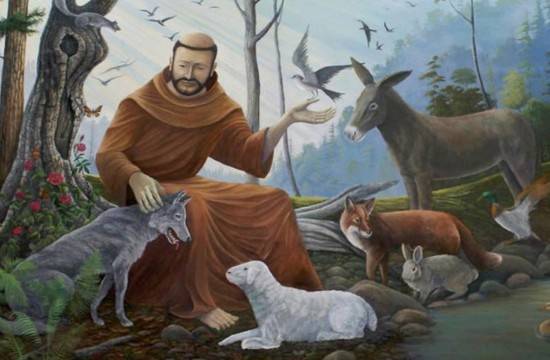Laudato si’: Three years on
Pope Francis’ encyclical has become the subject of many studies, conferences and new publications, illustrating its richness
Mural of St Francis, St. Francis Parish, Seffner, Florida, United States.
Pope Francis’ long-anticipated 2015 encyclical Laudato Si’ has not disappointed its readers, receiving a broad and enthusiastic welcome in a rare phenomenon for a magisterial document of the church.
The encyclical has aroused great interest from the time of its publication and this has continued. Indeed, Pope Francis’ encyclical has become the subject of many studies, conferences and new publications, illustrating its richness.
One of these studies, a joint article by Canadian theologian C. Vanin and Australian theologian Neil Ormerod*, which asks “what does ‘ecological conversion’ really mean?” is in my view particularly incisive and suggestive.
The article explains the importance of the notion of ecological conversion (LS, Chap. III, §216-221) as well as its theological and spiritual significance.
It also shows how the latter enables us to interpret the significant current overlap between the ecological anthropological crises facing the world.
Here, it is necessary to link Pope Francis’ concept of integral ecology (LS §10-11 and Chap. IV) with that of ecological conversion.
In effect, conversion is a process that can be understood as having four dimensions: religious or spiritual, moral, intellectual and psychological. Moreover the concept is applicable to Catholics as well to other believers.
Religious conversion opens us up to the love of God, to loving him naturally but also to love that which God loves in the way that God loves it.
Thus, ecological conversion opens us up unconditionally to the whole created universe.
“’For they are yours, O Lord, who love the living.’ (Wis 11:26) This is the basis of our conviction that, as part of the universe, called into being by one Father, all of us are linked by unseen bonds,” Francis explains.
“Here I would reiterate that ‘God has joined us so closely to the world around us that we can feel the desertification of the soil almost as a physical ailment, and the extinction of a species as a painful disfigurement.’” (LS §89).
In the view of Vanin and Ormerod, the moral and cultural dimension of conversion is key.
Drawing on other studies, their article explains that the central issue in the encyclical is the re-balancing between the cultural anthropological and the cultural cosmological axis of life and church doctrine over the course of centuries.
Historically, Christianity contributed to making a place for the human being at the heart of the pagan cultures of antiquity. It achieved this via the concepts of the human person and consciousness.
Thus, the rational and political western concept of this subject has progressively taken over, obscuring the link to the cosmos and its symbolism, which became suspect and associated with witchcraft, paganism and various heresies.
It was as if the church and Western culture from the end of the Middle Ages and the Modern Era had abandoned the cosmos.
The summit of this movement can be found in the invention of an exclusive, atheistic humanism of the 19th century, where humans were re-conceived in the place of God as dominating the world by their intelligence and their machines.
Consequently, nature was understood as simply subject to domination and exploitation for economic and consumer needs.
This is where the figure of St. Francis of Assisi is decisive for the encyclical.
In effect, at the very moment when an anthropological imbalance began to weigh on medieval history, St. Francis emerged at the center of cosmological and anthropological culture.
With St. Francis, it is possible in the same canticle to re-hear both damaged nature and sinful humanity as well the beauty of the cosmos and the greatness of humankind.
The common home “cries out to us because of the harm we have inflicted on her by our irresponsible use and abuse of the goods with which God has endowed her,” the encyclical reads.
“We have come to see ourselves as her lords and masters, entitled to plunder her at will. The violence present in our hearts, wounded by sin, is also reflected in the symptoms of sickness evident in the soil, in the water, in the air and in all forms of life.” (LS §2).
For St. Francis and Pope Francis, ecological conversion consists in taking care of the nature that we have wounded. It is a matter of loving what God loves as God loves it.
Ecological conversion thus involves anthropological conversion but certainly not anthropocentrism.
*C. Vanin, N. Ormerod, Ecological Conversion : What Does it Mean?, Theological Studies, 2016, Vol. 77.
Joël Molinario is director of the Higher Institute for Pastoral Catechetics (ISPC) in Paris.
By Joël Molinario
Published on the La Croix International Website.


